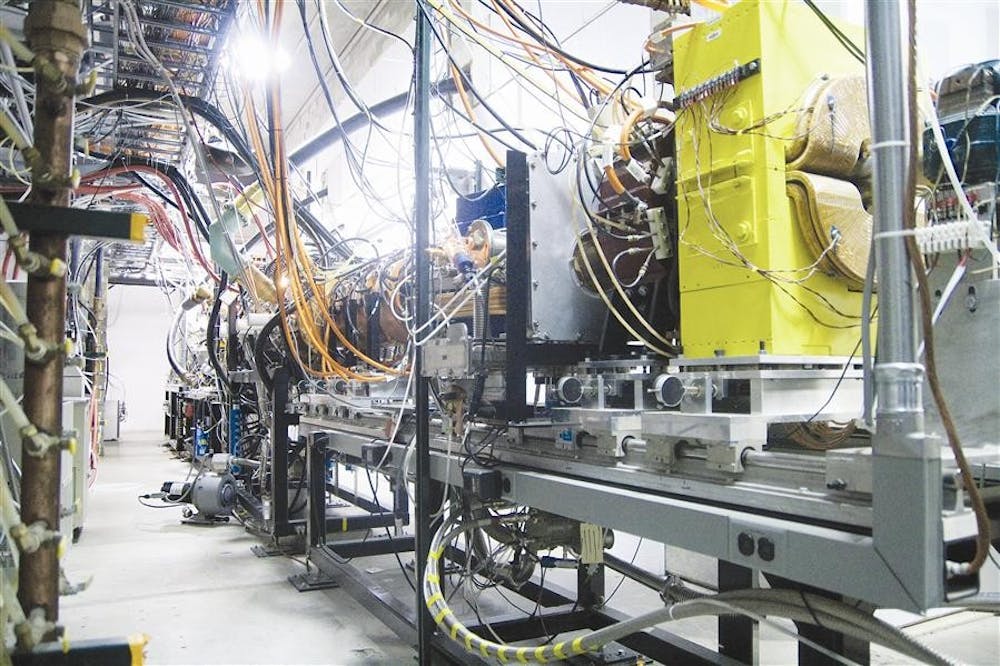Imagine waking up to a world with only women and no men, cats and no dogs, black and no white.
This is the reality for experimental physicists. Their problem is simple: Almost half the universe is missing.
The Large Hadron Collider at the European Organization for Nuclear Research in Switzerland, the machine that can find the missing half, reopened in October after two years of repairs.
More than 30 IU physicists have worked on the Collider, building a part called the Atlas Detector, which collects the debris from atomic collisions to hunt for the Higgs boson, the missing piece in the Standard Model theory of physics.
According to the model, every particle of matter has an opposite particle of antimatter. The “matter” is what makes up the universe that we can see; everything is made from matter. The antimatter, however, is almost entirely missing.
The Standard Model explains the lack of antimatter by predicting the existence of the particle called the Higgs boson, which gives mass to everything, and can turn antimatter into matter.
The Collider is a high-energy approach to finding the Higgs, where physicists smash atoms together at almost the speed of light and examine the debris, like atomic car crash investigators.
“Imagine a ping-pong ball in molasses. It’s hard to push, so it feels like the molasses gives it weight,” physics professor Hal Evans said. “That is what the Higgs boson does. It is the molasses of the universe.”
The advantage of the high-energy approach is that it can simulate events that would normally only occur in the center of stars. The disadvantage is the enormous cost and a lack of focus.
“It’s like throwing two garbage cans at each other and seeing what comes out,” said Joshua Long, a precision researcher at the Cyclotron.
The other method is the precision path, which, while relatively cheap, takes a long time to perfect. The Electric Dipole Moment Experiment at IU is a precision method, looking for the evidence left behind by the Higgs. Precision research is like an onion, with each layer revealing a more precise layer beneath.
The two methods are pursuing the Higgs boson together because the strengths in one cover the weaknesses in the other.
“High energy and precision are complimentary. Each one teaches you different things,” said Ed Stephenson, a senior research scientist at the IU Cyclotron Facility.
Chen-Yu Liu, a physicist working at the Cyclotron, stands among the blinking lights, buzzing motors and coiled cables of her EDME, looking affectionately at the new $240,000 refrigerator. At room temperature atoms have lots of energy, which makes precise measurements impossible. To stop the “jiggling,” the refrigerator cools Liu’s apparatus to minus 459 degrees Fahrenheit, just above absolute zero.
The Electric Dipole Moment Experiment that Liu is working on was first proposed 50 years ago, and so far no one has got it right. If her precision project is successful, it will prove the Higgs exists. Liu hopes to build an even more precise version of the experiment if the current one does not succeed.
“Ninety percent of the time is just getting it to work,” Liu said. “To build and take ownership of the experiment – it is part of the fun.”
A new generation of high energy and precision experiments is being designed even before the Higgs has been found.
Evans said that the next high-energy physics project for IU is the International Linear Collider, which will be more focused than the current Collider because it will smash smaller particles together, producing less wreckage – less garbage in the garbage cans.
Evans sits at a desk in Swain Hall West, on the other side of the campus from the Cyclotron. Fingers interlocked, he reflects on his commitment to the Collider.
“I go to CERN whenever I can. I spent one week in fall, one in spring and I spend most of my summer there,” he said.
For IU physicists, understanding is an end in itself. But for everyone else, there are more tangible benefits: the Internet, microchips and medical imaging are just some of the offshoot discoveries to come out of high-energy and precision research.
“Our whole modern economy is based on discoveries made by experimental physicists,” Evans said. “The investment today is the technology of tomorrow.”
The massive, the minute

Get stories like this in your inbox
Subscribe





